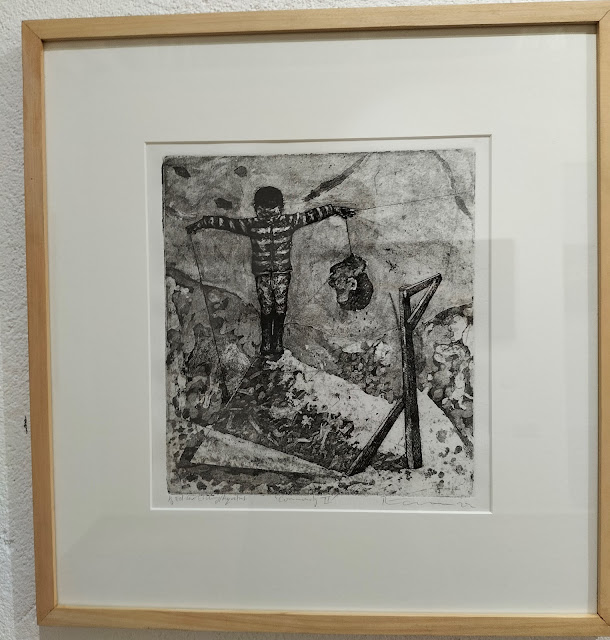By Margaretta wa Gacheru (April 22,2022)
There were
performing arts in Kenya long before the British colonizer came and claimed, as
the Donovan Maule Theatre did, that it was bringing the best of London’s West
End theatre to the deepest of dark Africa.
Long before
a National Theatre was established in 1952, there were Kenyan people performing
orature (oral rather than written literature) in the form of storytelling,
singing of original songs or those handed down from generation to generation,
and even dancing in rituals and ceremonies marking events like harvests and
weddings and births of treasured new borns.
But a number
of communities were stripped of those traditions once the new religion,
Christianity, came in and deemed most of those indigenous traditions ‘bestial’
or ‘primitive’ or even ‘sinful’.
It wasn’t
until 1977 that people in Central Province had the opportunity to watch an
original play in their own language and in a theatre that the local people of
Kamiirithu had constructed themselves.
Ngaahika Ndeenda
was written by two academics, Ngugi wa Thiong’o and Ngugi wa Mirii who
collaborated with members of that community to both create the stage and refine
their script to make it most relevant to the lives of the locals.
The play was
a smash hit, attracting people from people from all over the countryside. It
was misunderstood by some Kenyans who claimed the two Ngugi’s were being
‘tribalists’. But what critics didn’t understand was that the play was meant to
inspired Kenyans in every nation, be they from the Lake, the Coast, or the far
North to script their own plays and tell their own stories in their own mother
tongues.
But the fact
that thousands of Kenyans flocked to Kamiirithu to watch a story which mirrored
so many facets of their own lives, threatened the powers that be. They had
never seen such a grassroot respond to community theatre, and they felt threatened,
sadly.
One Ngugi
was detained. The other fled the country. But that play has never been
forgotten. And on May 12th, the English version of Ngaahika Ndeenda,
I will marry when I want, will be staged at Kenya National Theatre.
The same
cast will perform the Kikuyu version of the play as well; and the show’s
director, Stuart Nash, hopes the public will come to see both versions of this
modern classic.
It has got a
star-studded cast including Bilal Mwaura, Nice Githinji, Martin Githinji, Angel
Waringe, Martin Kigondu, Maryanne Nyambura, and Anne Stella as Gathoni. All of
them are popular actors best known to those who watch cable television or live
theatre productions.
For
instance, Bilal was last seen in ‘Crime and Justice’ while Nice starred in
‘Rafiki’. Martin Githinji made his most indelible mark in ‘Sue na Johnnie’ as
did Anne Stella, while Martin Kigondu is both an actor as well as a playwright
and producer/director of a number of original plays. Angel was Miss Morgan in ‘Tahini
High’ while Maryanne has been the backbone of Fanaka Arts.
There is
also a massive cast of singers, dancers, and characters who also play essential
roles to bring this marvelous play to vibrant life.
Rehearsals
for both Kikuyu and English versions of ‘I’ll Marry When I Want’ are in full
swing. Nash is a professional who has had decades of experience both producing
and directing theatre as well as starring in it when he was abroad.
The former
Artistic Director at KNT has already proven his worth by staging popular
musicals such as ‘Jesus Christ Superstar’, ‘Sarafina’, ‘Grease’, “Annie’, and
‘Caucasian Chalk Circle’. Nash is also the founder and artistic director of the
Nairobi Performing Arts Studio (NPAS) which recognized the need of young
Kenyans for professional training in the performing arts. Many of them have
gone on to develop careers in theatre, television, film.
The story of
Ngaahika Ndeenda is a delicate one. It is all about land and religion,
hypocrisy and duplicity, class and the deep disparity between rich and poor in Kenya.
It has wonderful comedic elements to it, but it also tackles hard core issues
that still have relevance today such misogyny, poverty, sexuality, and the role
that religion has played and continued to play in Kenyan society.
It is said
that Ngugi’s play has been staged in other parts of the world. But it’s been
nearly 45 years since Ngaahika Ndeenda was shut down by the State. No one
expects that this time round, there will be a similar reaction from the powers
that be.
“The
political climate has changed a lot since those dark old days,” says Fanual
Mulwa, assistant director of the play.






















